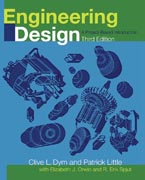
Engineering design: a project based introduction
Dym, Clive L.
Little, Patrick
Orwin, Elizabeth J.
Spjut, R. Erik
Engineers continue to turn to Engineering Design to learn the tools and techniques of formal design that will be useful in framing the design problems. Insights and tips on team dynamics are provided because design and research is increasingly done in teams. Readers are also introduced to conceptual design tools like objectives trees, morphological charts, and requirement matrices. Casestudies are included that show the relevance of these tools to practical settings. The third edition offers a view of the design tools that even the greenest of engineers will have in their toolbox in the coming years. INDICE: 1 Engineering Design. 1.1 Where and when do engineers design? 1.2 A vocabulary primer for engineering design. 1.3 More on design and engineeringdesign. 1.4 On the evolution of design and engineering design. 1.5 Managing engineering design. 1.6 Notes. 1.7 Exercises. 2 The Design Process. 2.1 The design process as a process of questioning. 2.2 Describing and prescribing the design process. 2.3 Strategies, methods, and means in the design process. 2.4 Getting started on managing the design process. 2.5 Case study and illustrative examples. 2.6 Notes. 2.7 Exercises. 3 Defining the Clients Design Problem. 3.1Identifying and representing the clients objectives. 3.2 On measuring things.3.3 Setting priorities: Rank ordering the clients objectives. 3.4 Demonstrating success: Measuring the achievement of objectives. 3.5 Constraints: Setting limits on what the client can have. 3.6 Designing an arm support for a CP-afflicted student. 3.7 Notes. 3.8 Exercises. 4 Functions and Requirements. 4.1 Identifying functions. 4.2 Design requirements: Specifying functions, behavior and attributes. 4.4 Functions for the Danbury arm support. 4.5 Managing the requirements stage. 4.6 Notes. 4.7 Exercises. 5 Generating and Evaluating Design Alternatives. 5.1 Using a morphological chart to generate a design space. 5.2 Expanding and pruning the design space. 5.3 Applying metrics to objectives: Selecting the preferred design. 5.4 Generating and evaluating designs for the Danbury arm support. 5.5 Managing the generation and selection of design alternatives. 5.6 Notes. 5.7 Exercises. 6 Design Modeling, Analysis and Optimization. 6.1 Some mathematical habits of thought for design modeling. 6.2 Design modeling of a ladder rung. 6.3 Preliminary and detailed design of a ladder rung. 6.4Notes. 6.5 Exercises. 7 Communicating the Design Outcome (I): Building Modelsand Prototypes. 7.1 Prototypes, models, and proofs of concept. 7.2 Building models and prototypes. 7.3 Selecting a fastener. 7.4 Notes. 7.5 Exercises. 8 Communicating the Design Outcome (II): Engineering Drawings. 8.1 Engineering design drawings speak to many audiences. 8.2 Geometric dimensioning and tolerancing. 8.3 Notes. 8.4 Exercises. 9 Communicating the Design Outcome (III): Oral and Written Reports. 9.1 General guidelines for technical communication. 9.2 Oral presentations: Telling a crowd whats been done. 9.3 The project report: Writing for the client, not for history. 9.4 Final report elements for the Danbury arm support project. 9.5 Managing the project endgame. 9.8 Notes. 9.7 Exercises. 10 Leading and Managing the Design Process. 10.1 Getting started: Organizing the design process. 10.2 Managing design activities. 10.3 An overview of project management tools. 10.4 The team charter: What exactly have we gotten ourselves into? 10.5 Work breakdown structures: What must be done to finish the job. 10.6 Linear responsibility charts: Keeping track of whos doing what. 10.7Schedules and other time management tools: Keeping track of time. 10.8 Budgets: Follow the money. 10.9 Tools for monitoring and controlling: Measuring our progress. 10.10 Managing the Danbury arm support project. 10.11 Notes. 10.12 Exercises. 11 Designing for .. 11.1 Designing for manufacture and assembly: Canwe make this design? 11.2 Designing for cost: Can we afford this design? 11.3Designing for reliability: How long will this design work? 11.4 Designing forsustainability: What about the environment? 11.5 Designing for quality: Building a House of Quality. 11.6 Notes. 11.7 Exercises. 12 Ethics in Design. 12.1 Ethics: Understanding obligations. 12.2 Codes of Ethics: What are our professional obligations? 12.2 Obligations may start with the client 12.4 . but what about the public and the profession? 12.5 Engineering ethics and the welfare ofthe public. 12.6 Ethics: Always a part of engineering practice. 12.7 Notes. 12.8 Exercises. References and Bibliography. Index.
- ISBN: 978-0-470-22596-7
- Editorial: John Wiley & Sons
- Encuadernacion: Rústica
- Páginas: 327
- Fecha Publicación: 11/09/2008
- Nº Volúmenes: 1
- Idioma: Inglés
